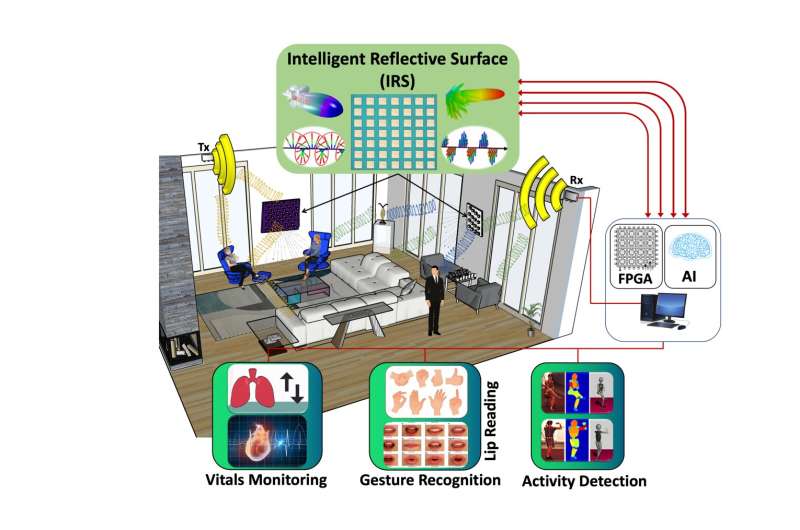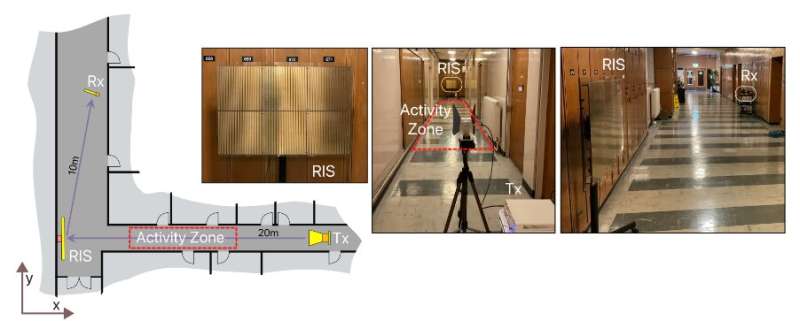Intelligent wireless walls for contactless in-home monitoring
by Light Publishing Center, Changchun Institute of Optics, Fine Mechanics And Physics, CAS

Patient health care strongly relies on in-hospital situation and remote monitoring at home is very challenging. Various human activity recognition systems have been proposed exploiting sensors, cameras and wearables. However, these techniques raise either privacy concerns or involve the discomfort of carrying wearables all the time. These concerns can be addressed by exploiting a contact-less human activity monitoring system.
One proposed method for remote patient monitoring is wireless channel sensing utilizing radio frequency (RF) devices. This means one must deploy additional active RF devices for patient health care and monitoring at home, which would be a costly solution. An unusual but common solution is to explore the ambient-stray signals which are already present in the environment, e.g., Mobile and/or WiFi signals. Furthermore, the patient or end-user acceptance is an issue if we install additional devices for health monitoring in homes, motivating the need to recycle ambient signals for monitoring.
In a new paper published in Light Science & Application, a team of scientists, led by Dr. Qammer H. Abbasi from the James Watt School of Engineering, University of Glasgow, UK have developed a reconfigurable intelligent surface (RIS) aka—”Intelligent Walls” for controlling the electromagnetic (EM) waves on the physical level and manipulating the propagation path to harness human activity data in a contactless manner.
RIS is typically composed of two layers, the first layer being a metasurface structure composed of tunable, subwavelength unit cell elements with subwavelength spacing, with a second layer accommodating a control and biasing network. Compared to technologies such as phased arrays and relays, a major advantage to employing RIS for EM transformations is their low complexity and passive nature, thereby making the technology easily scalable to cover large surface areas at low manufacturing cost and with minimal power consumption.
Empowered with artificial intelligence (AI), the work aims to offer a paradigm shift in contactless in-home activity monitoring by introducing the RIS to extend the coverage region of an activity monitoring system which can help in tracking and improving resolution by focusing the beam. The sensing capabilities of the RIS-aided activity monitoring system is demonstrated in complex wireless propagation environments where conventional microwave sensing cannot perform well. Namely, sensing around a corner in a corridor junction and sensing across multiple floors.

The developed intelligent wall can be manipulated to steer the beams in various directions. Due to broader scan angle, activity detection and monitoring can be performed in wide open spaces. The advantage provided by the experimental setup is that activities can be performed in real time and the beam could be switched to multiple locations allowing patient monitoring in different spaces. The scientists summarize the operational principle of their Intelligent Wall as follows:
“We design a high resolution programmable intelligent surface for three purposes, (1) to be able to scan and point the beam at multiple locations and/or floors; (2) to focus the EM energy at desired position such that it avoids undesired interferences from surrounding environment; and (3) to be able to identify various body positions such as sitting, standing and walking using machine learning algorithm by utilizing EM energy collected from the intelligent surface.”
“Since the switching rate and the wide scan angle of the intelligent wall is faster and broader, the number of people monitored in principle can be very large but existing work is limited to single person only,” they added.
“The presented technique can be used to monitor patient with profound disabilities, e.g., Freezing of gait (FoG) which is one of the Parkinson’s diseases symptoms, the patients may find inability to walk properly and is prone to fall and serious injury. This breakthrough could open a new venue for the intelligent walls to be used for remote patient monitoring to enable the prediction of future trends and events, using AI making a proactive home health-monitoring environment,” the scientists say.
Muhammad Usman et al, Intelligent wireless walls for contactless in-home monitoring, Light: Science & Applications (2022). DOI: 10.1038/s41377-022-00906-5
Provided by
Light Publishing Center, Changchun Institute of Optics, Fine Mechanics And Physics, CAS
Citation:
Intelligent wireless walls for contactless in-home monitoring (2022, July 18)
retrieved 18 July 2022
from https://techxplore.com/news/2022-07-intelligent-wireless-walls-contactless-in-home.html
This document is subject to copyright. Apart from any fair dealing for the purpose of private study or research, no
part may be reproduced without the written permission. The content is provided for information purposes only.
For all the latest Technology News Click Here
For the latest news and updates, follow us on Google News.

